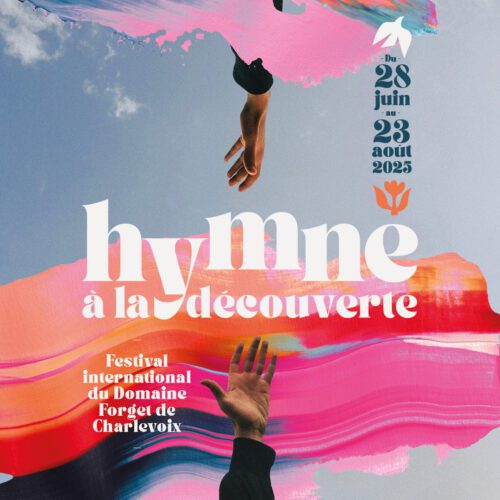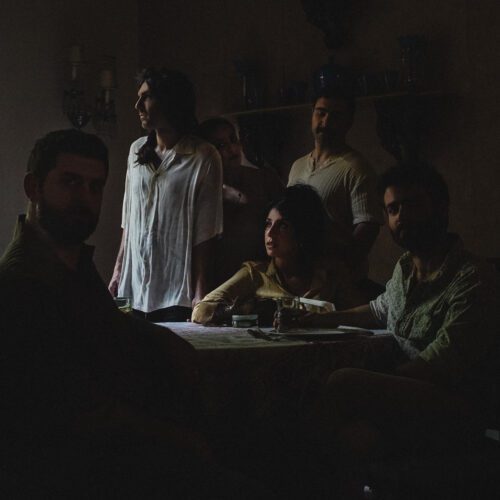Additional Information
Golgot(h)a, a piece composed by Walter Boudreau 3 decades ago and recently reworked for its upcoming performance this Sunday at the Montreal / New Musics Festival, illustrates what the composer calls his “historical-cultural bestiary.
“The ritual of the Catholic mass, the nuns of the Congregation Notre-Dame with whom I had my first piano lessons, the sin (of the flesh…) admitted (with clenched teeth) in the confessional, religious choral singing, church bells and the organ, the fear of Eternal Damnation, sexual pleasure, artistic ecstasy, gladiator movies… and what else!” Walter Boudreau says in his history of the work at hand. Thus, the sounds of sacred music, deeply rooted in his childhood and adolescent imagination, come to the fore through the metaphor of the Stations of the Cross, illustrated in all Catholic churches as we know.
“Although I am not really religious,” adds the composer in his notes, “the way of the cross is to my eyes the most intense representation of the drama of a human being in front of the inevitable. This long tunnel of great darkness is the terrible funeral march of a man condemned to an abominable torture: the crucifixion.”
Golgot(h)a” was conceived in 1989 when Walter Boudreau was commissioned by a patron to celebrate the refurbishment of the Guilbault-Thérien organ at the Grand Séminaire de Montréal as part of the 150th anniversary celebrations of its founding.
While visiting the superb chapel of the Grand Séminaire and its organ, Walter Boudreau was immediately struck by the 14 stations of the Way of the Cross of the Passion of Jesus Christ, hence Golgot(h)a . In his opinion, this mystical journey, which was well known to French-speaking Quebecers in his Catholic era, was an obvious choice for the structure of the work…., which took longer to compose than expected.
PAN M 360: So first we are in the chapel of the Grand Séminaire, the origin of Golgot(h)a. Remind us of the context:
WALTER BOUDREAU: At the time, I was newly appointed composer-in-residence at the Toronto Symphony Orchestra, I was doing Toronto-Montreal non-stop. I’m newly seated in the cockpit of the artistic direction at SMCQ. I have composition commissions. I conduct the Metropolitan Orchestra regularly. I tour. So I get the commission and I say okay, I’m going to go see this and right away. What strikes me is the way of the cross. Immediately I have the idea of paintings for an exhibition. I know these paintings because when I was young, you had to follow them on your knees, praying if you had committed a sin of the flesh. At the age of 12, 13 or 14, you knew immediately who had done that sin when you saw him doing his penance in church! So the Stations of the Cross for me, I must confess that I often did it on my knees, it stuck in my head – raised in Sorel in the Catholic religion, next to St. Pierre’s church which I abandoned when I was eleven years old with the agreement of my agnostic grandmother who raised me. My mother was an organist and pianist who played in the church. I sang religious music, it is part of me, of my Quebec identity.
PAN M 360: On familiar ground, then.
WALTER BOUDREAU: This order, it was perfect for me. I started working there, right away, I didn’t think about the financial aspect because I had an income. At one point, however, I had been working for a couple of months and I needed a payment to continue. The patron then invited me to the restaurant to finally declare that he was in love with me. I remained polite. I got up and left, telling myself that I would work on the piece in my spare time.
PAN M 360: Which did not guarantee the delivery of the work!
WALTER BOUDREAU: I went to see Denis Regnaud, then director of the music section of the now defunct CBC’s Chaîne culturelle, and he suggested that I reduce the initial length of the work from 45 minutes to 30 minutes in order to meet the criteria of the Grand Prix Paul-Gilson of the Communauté des Radios Publiques de Langue Française (CRPLF). Among these criteria, it was necessary to include innovative techniques in radio production at the time – voice transformation, digital sampling, new multitrack techniques, etc. Being familiar with these techniques, I accepted the proposal. For example, I had to work with a choir of sampled voices rather than with real choristers or soloists. At the time, my colleague (and composer) Alain Thibault worked alongside me to complete the work, given his high expertise in digital technologies.
PAN M 360: You then collaborated with Raoul Duguay, whom you had known long before the SMCQ, that is to say at the time of Infonie.
WALTER BOUDREAU: Raoul Duguay wrote the texts and was the reciter – instead of Gaston Miron, that the patron (resigned) had initially suggested. I got along very well with my old friend Raoul, who gave me some pretty good heptasyllables, since it was 14 Stations of the Cross that I divided into 2. Golgot(h)a is thus divided into two large parts, each comprising seven sections. Each section is preceded by a “fanfare-promenade” that acts as a transition between the sections. And so everything revolved around the number 7, which is why Raoul delivered 28 heptasyllabic poems to me. In the studio, Raoul had recited three versions of his texts, including one with the syllables well detached, which I had then digitized to give the phrases rhythms that Raoul could not have executed. By modifying his voice, moreover, I had made the reciter a sort of Darth Vader to embody the “voice of destiny”. This time, the actor Pierre Lebeau will be the narrator.
PAN M 360: The work finally made its way !
WALTER BOUDREAU: And I had been paid for the commission and for conducting. The work was recorded according to these standards, presented in Paris in May 1991 and won the Prix Paul-Gilson – we are 3 Quebecers to have won it: Otto Joachim, René Lussier and myself. It was a beautiful adventure but for me it remained an unfinished work.
PAN M 360: So what about Golgot(h)a 30 years later ?
WALTER BOUDREAU: I had won a prize but I had it left across the throat. I had built a terrace in my yard, something nice, but I didn’t finish it. So recently, since I am now retired from the artistic direction of the SMCQ, I could work on it again. Many of my works needed a brush stroke, some sanding, a few more nails. Today, I have the time when I was busy doing so many things at once, I even had to compose during my conducting breaks because I was so overloaded. It is a miracle for me to have been able to produce works at that time. A real way of the cross! (laughs). And now, at 75 years old, I am very happy to put the final coat of varnish. At least, I hope so!
PAN M 360: In your history of the work, you explain that all the music was derived from a four-part responsory “Tradiderunt Me In Manus Impiorum” (“They have delivered me into the hands of the impious”) from the “Officium Hebdomadae Sanctae” (“The Passion”) by the Spanish Renaissance composer Tomas Luis De Victoria (1548-1611). In Golgot(h)a, this motet is intended as a historical link to contemporary compositional techniques at the time of its conception. Is this aspect further emphasized in the completion of the work?
WALTER BOUDREAU: This time I have real voices singing in Latin, a soprano, a mezzo, a mixed choir. I even called upon the voice of the composer to help me with this. I even called on the ayatollah of Latin choral singing, Yves Saint Thomas, to guide me, to allow me to enter the text and add something new.
PAN M 360: And who’s conducting this time, since you haven’t appeared in public for quite some time?
WALTER BOUDREAU: That would be me ! I’ll show my face! I’ll do it when and where I feel like it! That being said, I found the orchestra directing job great, it allowed me to see that I wasn’t the only one with good ideas. Now that I’m no longer the artistic director of the SMCQ, and I haven’t overplayed myself before, I’ll be conducting concerts of my music instead, although I do occasionally for other composers – Steve Reich, for example, whose “Tehilim” I dream of doing.
PAN M 360: His most mystical work!
WALTER BOUDREAU: Yes, it is. Come to think of it, we could have played it at this edition of Montreal / New musics, whose theme is “music and spirituality”…
AT MONTREAL/NEW MUSICS FESTIVAL, GOLGOT(H)A IS PERFORMED NEXT SUNDAY, 3PM, AT SALLE PIERRE-MERCURE
Participants
- Raymond Cloutier, narration
- Virginie Mongeau, soprano
- Marie-Annick Béliveau, mezzo-soprano
- Jean-Willy Kunz, organ
- Chœur de l’église Saint Andrew & Saint Paul
- Ensemble de la SMCQ
- Walter Boudreau, conductor
- Cristian Gort, conductor
Program
- Les Communiantes (1977), 17:00Claude Vivierorgan
- Tradiderunt me in manus impiorum (Ca. 1585), 2:30Tomás Luis de Victoria4 voicesCristian Gort, conductor
- Golgot(h)a (1990)Walter Boudreau / Raôul DuguayPremiereVersion 2007, 22 [original work]narrator, soprano, mezzo-soprano, mixed chorus (SATB), 2 horns, 2 trumpets, 2 trombones, tuba, organ, 5 percussions and processing2022 versionWalter Boudreau, conductor
- pré-préludeVersion 2007, 22 [original work]
- préludeVersion 2007, 22 [original work]
- fanfare 1aVersion 2007, 22 [original work]
- station 1Version 2007, 22 [original work]
- fanfare 2Version 2007, 22 [original work]
- station 2Version 2007, 22 [original work]
- fanfare 3Version 2007, 22 [original work]
- station 3Version 2007, 22 [original work]
- fanfare 4Version 2007, 22 [original work]
- station 4Version 2007, 22 [original work]
- fanfare 5Version 2007, 22 [original work]
- station 5Version 2007, 22 [original work]
- fanfare 6Version 2007, 22 [original work]
- station 6Version 2007, 22 [original work]
- fanfare 7Version 2007, 22 [original work]
- station 7Version 2007, 22 [original work]
- fanfare 1bVersion 2007, 22 [original work]
- interludeVersion 2007, 22 [original work]
- fanfare 8aVersion 2007, 22 [original work]
- station 8Version 2007, 22 [original work]
- fanfare 9Version 2007, 22 [original work]
- station 9Version 2007, 22 [original work]
- fanfare 10Version 2007, 22 [original work]
- station 10Version 2007, 22 [original work]
- fanfare 11Version 2007, 22 [original work]
- station 11Version 2007, 22 [original work]
- fanfare 12Version 2007, 22 [original work]
- station 12Version 2007, 22 [original work]
- fanfare 13Version 2007, 22 [original work]
- station 13Version 2007, 22 [original work]
- fanfare 14Version 2007, 22 [original work]
- station 14Version 2007, 22 [original work]
- postlude IVersion 2007, 22 [original work]
- postlude IIVersion 2007, 22 [original work]























